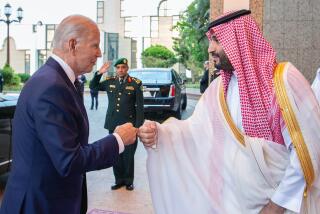Saudis take cue from Obama
- Share via
BEIRUT — Facing a global economic slowdown and plummeting oil prices, the government of Saudi Arabia is taking a page from President-elect Barack Obama’s book and pouring additional billions of dollars into public works, even as the country expects its first budget deficit in six years.
But unlike the United States, Saudi Arabia will be drawing from its substantial savings, rather than issuing new debt.
Even though it is cutting expenses by about 7%, Saudi Arabia will invest about $60 billion in public works projects, nearly half of its $127-billion fiscal 2009 budget. The public works spending is projected to be about 36% higher than for the previous year.
Much like Obama’s plan to jump-start the U.S. economy by injecting capital into education and public infrastructure, Saudi Arabia is focusing on its schools, universities, clinics, waterworks, roads and telecommunications.
“There are a lot of projects being carried out in the kingdom,” said Qussay Badran, editor in chief of the Saudi magazine Al Eqtisadiah, or the Economist. “The pace of development projects in the education, health, transportation sectors has not slowed down despite the international crisis.”
With the world’s largest oil reserves, a population of 27 million and guardianship over Islam’s holiest sites, Saudi Arabia is the richest, largest and most influential of the Arabian peninsula states. Booming for years on record oil prices and real estate speculation, Persian Gulf economies have lately seen their fortunes lag as energy collapsed and world credit markets contracted.
Stock markets in the Persian Gulf states have fallen dramatically since the beginning of the year, with the Saudi Tadawul All-Share Index down nearly 60%. Foreclosures have begun to mount as those who bought property during a time of easy credit begin to default on loans.
With an estimated $450 billion in foreign currency stored up during the recent oil boom, however, Saudi Arabia will be better prepared than most nations to weather the storm.
Analysts say Saudi Arabia’s saving policies over the last several years have given it a well of liquidity it can draw from during hard times.
New projects will include vocational schools, a women’s university, primary care clinics, hospitals, sports clubs, roads and bridges, as well as improvements to ports and railway infrastructure. In addition, $20 billion in loans are to be made available to the real estate and finance industries.
Pricey public works projects keep the country’s restless youths and migrant workers employed, besides benefiting politically tied contractors.
“The real challenge is how to translate this wealth and huge liquidity into projects that benefit the people directly,” Sulaiman Hattlan, a Saudi writer and former editor of Forbes Arabia, said in an interview from his home in Dubai, United Arab Emirates.
“You need people to feel like they belong to a rich country,” he said. “They are implementing projects that are really important for the basic structure of the Saudi economy.”
But Badran warned that the economy and stock market could be hit even harder than expected next year. The Saudi Finance Ministry has predicted that a collapse of oil prices will slash government revenue from $293 billion to $109 billion next year. The economy’s growth is expected to fall from 4.2% to as low as 1.5%.
“The government should . . . be careful about spending in the next year because of the international recession that could affect the demand on oil and lead to a decrease in oil prices,” Badran said. “All these indicators should make the government more careful about spending.”
--
Rafei is a special correspondent.
More to Read
Sign up for Essential California
The most important California stories and recommendations in your inbox every morning.
You may occasionally receive promotional content from the Los Angeles Times.













